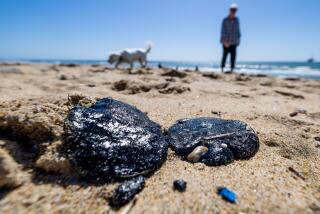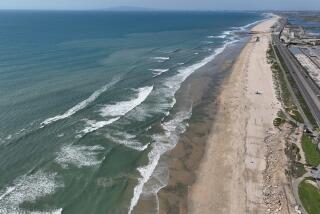Tests Find Leak Probably Caused Tar Balls
Adding fuel to the fierce debate about oil drilling off Californiaâs coast, U.S. Coast Guard laboratory tests have concluded that tar balls found on an Orange County beach in June probably came from a massive offshore oil-drilling complex.
Tar balls collected at pristine Crystal Cove State Park, though they caused no significant environmental harm, matched samples taken from an oil spill near the offshore platform named Eureka, where a June 5 leak from a faulty pipeline alarmed and angered environmentalists.
Although it is possible that the tar balls could have formed from oil seeping naturally from the ocean floor, such a scenario is âhighly unlikely,â said Chief Petty Officer Mark Stephens at the U.S. Coast Guard station at Long Beach.
The preliminary laboratory findings are key to ongoing federal and state probes of the June pipeline leak. Although platform operators say less than a barrel of oil leaked from the underwater pipeline, it formed a sheen two miles long and 20 yards to 100 yards wide. A barrel contains 42 gallons of oil.
The complex, which is for sale, is operated by Aera Energy LLC, a partnership of Mobil Oil Corp. and Shell Oil Co. An Aera Energy representative said company officials have not seen the test results and will take no position until they do, other than to defend their track record at the site.
âThe critical thing with the lines weâre talking about is that as soon as the release was detected, we shut that line [down], and it has been shut ever since,â said Susan Hersberger. âAera is a very good operator, and we devote a lot of time and attention and resources to [spill] prevention. In the very, very rare occasions when there is a release of fluid, we have the resources and we respond immediately.â
Critics, however, said the small leak was a prime example of why federal officials should not extend 40 offshore drilling permits all along the coast.
Several days after the sheen formed, gooey black tar balls--formed from floating oil that gathers in globs--began washing up on several beaches in Orange County, from Huntington Beach south to Dana Point.
The link to the tar balls âunderscores all our concerns,â said Susan Jordan, who monitors drilling issues as a board member of League for Coastal Protection. âOne can only imagine what the impact would be if there was a mishap related to the development of the 40 offshore leases, which contain roughly one billion barrels of oil.â
But state Department of Fish and Game Warden Michael McDermott downplayed the significance of the finding.
âThis tar ball situation was minor . . . there were no environmental impacts, there were no animals harmed or damaged. What washed up on the beaches was extremely minimal,â he said. âPeople are making more out of this than they should.â
State and federal officials investigating the spill say it is too early to say definitively if Bakersfield-based Aera Energy could face civil or criminal penalties because of the spill.
âIf the match shows it is Aeraâs product, they are liable for that release,â McDermott said.
Fish and Game officials are conducting their own probe, which might result in criminal charges if investigators find that Aera could have prevented the spill through proper maintenance and other procedures, McDermott said. On the other hand, he said, the state might find that Aera could not have stopped the spill.
The Coast Guard could also levy fines. A U.S. Minerals Management Service representative said that the federal agency may pursue civil or criminal penalties beyond any action taken by the Coast Guard.
The leak received widespread attention because it occurred just three days before a contentious and emotional state Coastal Commission session addressing the possible resumption of oil exploration off Californiaâs Central Coast. Gov. Gray Davis and the stateâs two U.S. senators oppose new drilling. The head of the Coastal Commission this week sent a letter to U.S. Secretary of the Interior Bruce Babbitt saying the commission had the legal right to review the federal proposals, and planned to do so, a first for any state.
Aera does not dispute that the oil sheen found the first Saturday in June seeped from a 1.8-mile-long ocean-floor pipeline later found to be leaking in seven spots along 3,500 feet.
The pipeline, now shut down, carried oil, water and gas from platform Eureka to platform Elly.
Federal officials suspect that the leaks were caused by internal corrosion.
(BEGIN TEXT OF INFOBOX / INFOGRAPHIC)
Tracing the Trouble
Tar balls collected at Crystal Cove State Park matched samples taken from an oil spill near the offshore platform Eureka, where a faulty pipeline leaked June 5.
More to Read
Sign up for Essential California
The most important California stories and recommendations in your inbox every morning.
You may occasionally receive promotional content from the Los Angeles Times.










